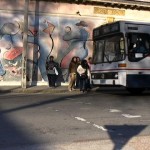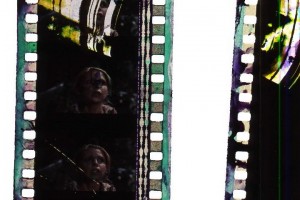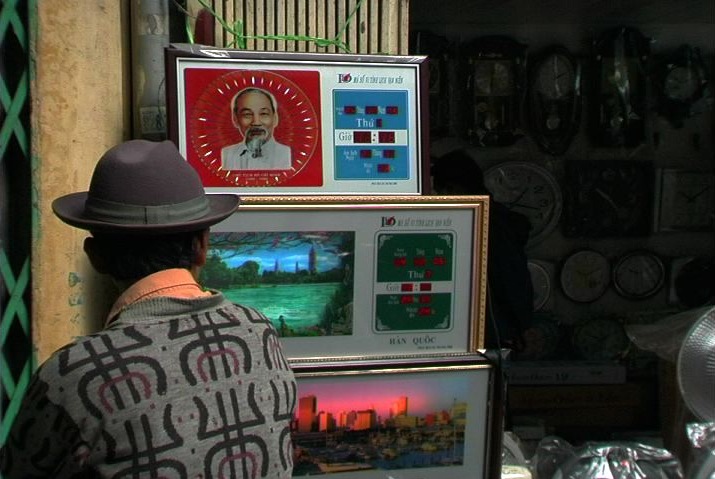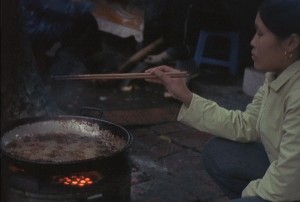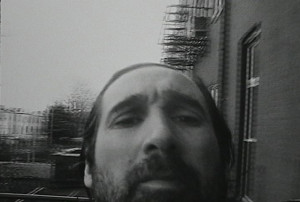| More: Films
An Argentine Excursion: Film Frames and Talk Therapy
August 27, 2009
An Argentine Excursion: Film Frames and Talk Therapy
By Mark Street and Lynne Sachs (with Pablo Marin)
Published in GONZO CIRCUS Spring 2009
Our cinematic relationship to Argentina began in March of 2007, when the Buenos Aires Festival Internacional de Cine Independiente (BAFICI) invited Lynne to show a retrospective of her films. During the one week she was in this film-crazy city, she met Pablo Marin and Leandro Listorti, two extraordinarily active Argentine filmmakers with a commitment to making movies and screening and writing about their thriving alternative film community. While most of Buenos Aires was boasting about the burgeoning movie industry in Palermo Hollywood, or a lunch-time spotting of temporary denizen Francis Ford Coppola, Leandro and Pablo were mining San Telmo flea markets for Super 8 cameras or rushing across the city to see a festival screening by American avant-garde super-star Jonas Mekas, age 80 and thriving. Lynne’s shared passion for experimental film quickly assured her that she had found a city she wanted to share with Mark, her husband and sometime artistic collaborator.
In June 2008, we packed our bags, got on a plane and moved to Buenos Aires for two months, studying Spanish as a family (with our two preteen daughters), shooting film and diving even deeper into the experimental film scene. We learned to speak Argentine Spanish (the “y” sound is pronounced “j”, so “Yo” becomes “Jo” and “pollo” become “pojo”), eat dinner late and spend hours sobremesa (at table) chatting and sipping wine into the night. This land can make you feel impatient and shallow, as the Argentine filmmakers we met seemed to relish spending time discussing their movies as well as the political issues of the day (multiple agricultural protests) in Europeanist distended style. Maybe it comes from the Argentine obsession with psychoanalysis, but talk is not considered passé here.
Our apartment was near the Museo d’Arte Latino Buenos Aires (MALBA) where we relished the best modern art collection in town, as well as a full film schedule. We saw a Hugo Fregonese retrospective, as well as the hilarious campy ¨Esperando la Carroza¨ by Juan Carlos Lenardi which friends had recommended. What a way to learn Spanish. It’s like learning English by watching “The Rocky Horror Picture Show.”
A lynchpin of the scene is the urbane and witty Ruben Guzman. A prolific filmmaker and programmer, Ruben had moved to Canada in the 80’s but recently returned to make work and program in Buenos Aires. The Kino Palais at the Palais de Glace shows 4 nights a week in a cavern-like space in the back of the museum. It’s an underground club hidden in a 19th century ice skating rink (no kidding). This is where we presented our X-Y Chromosome Project, a subjective take on global warming, to the Buenos Aires community for three nights in July. Here’s what they saw:
From archival snips of an educational film on the weather to cine poems in full blossom, New York film “avant-gardeners” Mark Street and Lynne Sachs present the X-Y Chromosome Project .This program of ten short films on both single and double screen gleans audio-visual crops from the dust of the filmmakers’ fertile and fallow imaginations. In this avalanche of visual ruminations on nature’s topsy-turvy shakeup of our lives, Street and Sachs ponder a city child’s tentative excavation of the urban forest, winter wheat, and the great American deluge of the 21st Century (so far).
Over Peruvian dinner, Ruben introduced us to Federico Windhausen, an Argentine-American media arts historian currently living and teaching in California, but a man whose Argentine roots run deep. Federico is the best informal cultural guide we’ve ever encountered, anywhere. He was constantly suggesting film screenings, theatre and dance pieces (in the plaza of the Biblioteca Nacional, for instance) and ice cream (helado) places. The Argentine obsession with ice cream is legendary. Once at an asado (barbecue) in the country, the conversation wound its way from politics to movies to children’s attributes with nary a raised voice. When it came time to order helados though the guests argued vehemently and passionately in defense of their favorite flavors.
Whenever we found the conversation turning to the subject of Argentine experimental film there was one name that never failed to come up: Narcisa Hirsch. Over the last forty years, this grand dame of South American cinema has earned a well deserved reputation for making extraordinary films that are both formally rigorous and deeply personal. Inspired by the feminists and the Fluxus artists she met and worked with in Europe in the 1960s and ‘70’s, Narcisa brought back her profound appreciation for avant-garde film to the artist community she knew and loved in Buenos Aires. In the company of her good friend Ruben and Paula Felix-Didier, the director of the Museo de Cine, Lynne spent a fascinating afternoon with Narcisa in her home-studio discussing her forty year filmmaking career, her children and grandchildren and her farm in Bariloche, in the south of Argentina.
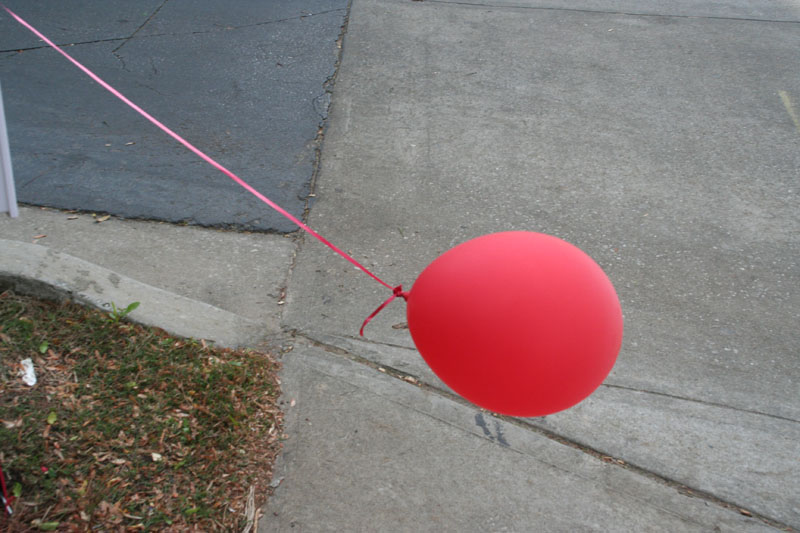
Pablo Marin is one of the guiding forces of experimental cinema in Buenos Aires, and his blog La Region Central (title taken from the Michael Snow film) is an amazing living document.
Once Pablo and Mark spent the hour just before dusk shooting 16mm film around some stands that sell meat and sausages right next to the Reserva Ecologica. Later Mark and he drank beers in a café on the Avenida Corrientes (sort of the psychic artery of the city). Mark asked him to give a quick historical overview of the past.
The early Argentine experimental period is represented by just a bunch of separate films, made by filmmakers that didn’t pursue a total exploration of the medium and, most importantly, didn’t think in terms of a community or movement. Horacio Coppola, a leading name in Argentinian still photography, made a few films during the 1920s and ‘30s. His most important is Traum, a 16mm film that reminds me of the French-German Surrealists.
Víctor Iturralde and Luis Bras were a couple of pioneers of experimental animation in the ‘50s and ‘60s. They mostly painted and scratched on celluloid films in 35mm, 16mm and Super 8mm.”
The 1970s and 80s were a strong and vital period for experimental film in Argentina. An actual alternative film community was born. During the 70s, we experienced a military coup d’etat which resulted in little contact with the experimental film world abroad. Our productions were more scarce and individualized. Many films were made (mostly all in 8mm and Super 8) but the conditions of exhibition were totally underground and unconnected (garages, houses, etc). All this began to change in the early 80s when Buenos Aires’ Goethe Institute began showcasing as well as protecting these films and filmmakers. Under the Goethe’s umbrella (to put it visually), this kind of film practice could grow without fear of persecution (that’s why the government reaction was never that intense) and with more support for the movement collectively. The highest point of this Goethe period (if one could call it that) was in 1980, when the Institute held a workshop of experimental film with German filmmaker Werner Nekes. In this period many artists were working, such as Claudio Caldini (Super 8, Single 8), Narcisa Hirsch (16mm, Super 8) and Jorge Honik (Super 8). Other names include Juan Villola, Horacio Vallereggio, Marie Louise Alemann, Juan José Mugni and Silvestre Byrón. The films where shown in bigger, more social, environments but the reaction of the audience was mostly hostile. Once at a screening of Caldini’s Gamelan the audience started booing and shouting and turning off and on the lights ! It is also important to note that in this period these filmmakers were more in touch with international, experimental film production. To name a few screenings, there’ was Jonas Mekas’ 1962 screening of Guns of the Trees at Mar del Plata Film Fest and in 1965 the Di Tella Art Institut screened a bunch of New American films (Mekas, Brakhage, Warhol, etc.). Besides that, Narcisa Hirsch traveled a lot to buy film prints that even today represent the most important private, experimental film archive in Buenos Aires.
Since 1990, experimental media has for the most part switched drastically towards video even though makers such as Caldini and Hirsch continue to produce films. The opening of several film schools makes experimental film more accessible and more studied. The public screenings of international works have gained a solid following mainly through Buenos Aires Independent Film Festival and Mar del Plata, and it is also more common to see screenings of local experimental works at these venues. Some of the important names are: Andres Denegri, Gustavo Galuppo, Gabriela Golder, Ruben Guzman (all in video), Daniela Cugliandolo (Super 8, video) and Sergio Subero (Super 8, video).
With this backdrop for experimental film all around us, we tried to let ourselves be charged as artists in Buenos Aires, too, and move ahead with our own work. Mark shot 16mm film and videotape attempting to capture the idiosyncrasy of the city, following up on his 2008 film Hidden in Plain Sight (a city symphony film shot in Dakar, Hanoi, Marseille and Santiago de Chile). He became obsessed with the cartonieres, the gleaners who sift through trash to sell cardboard on the outskirts of town, and the portreros, the men who sit behind glass windows at middle class apartment buildings watching and waiting. He is currently editing the project, tentatively titled Fans of Argentina (based on the store displays that feature industrial fans running at different speeds, like enormous film shutters).
With Argentine super 8 filmmakers Leandro Listorti, Pablo Marin and Tomas Dota, Lynne shot an experimental narrative inspired by Julio Cortazar short story Final del Juego about four girls who stand by a passing train everyday posing like “sculptures and attitudes.” The film is very much about longing, the rite of passage between childhood and adulthood, and performance of an inner self. The crew of cinema friends shot with a real potpourri of formats – from obsolete Kodak Regular 8 to Super 8mm, 16mm and video. Our daughters Maya and Noa and their two Argentine friends Lena and Chiara Peroni were hopping on and off trains throughout the summer as part of the production. The film used the entire city as a set – including the Tigre Train line that sweeps through the Parque Palermo, the majestic Retiro train station, the flea market in San Telmo’s Plaza Dorrego, and a quiet backyard on the outskirts of the city.
Our last day in Buenos Aires we walked a few blocks to a huge multiplex and caught Lucretia Martel’s brandnew “La Mujer Sin Cabeza” while our kids took in a dubbed version of Mamma Mia at the screen next door. As we munched a last alfajore walking back to the apartment to collect our security deposit we came up with the idea of curating a film screening in NYC upon our return.
On February 21, 2009, we showed thirteen Super 8, video and 35mm films from Argentina at Anthology Film Archives in New York City. In curating “Ventana al Sur: An Evening of Argentine Experimental Film” we culled films from a whole array of non-traditional works made over the last 3 decades, some by veteran masters and mistresses (Leandro Katz, Liliana Porter and Narcisa Hirsch) and some by young upstarts and renegades (Pablo Marin, Ruben Guzman, Macarena Gagliardi, Sergio Subero,Leandro Listordi, Ernesto Baca) with newfound passions for the moving image. Here are descriptions of just a few of the works we showed:
Leandro Katz’s “Los Angeles” (5 min., 16mm, 1976) is a portrait of a small community living by the railroad tracks in the banana plantation region of Quiriguá, Guatemala. Originally a single take, this film alternates equal number of moving frames and frozen frames as the camera tracks alongside the train station.
Narcisa Hirsch’s Workshop (10 min.,16mm 1977) is a structuralist vision. One wall of the filmmaker’s studio as seen through a fixed camera. We see photos she’s stuck on the wall, then there is a dialogue with a male friend to whom she is describing the rest of the walls that you don’t see. A “one upmanship” of a similar film by Michael Snow where he describes a wall of his studio- workshop, by describing what one CAN see.
Bajo Tierra (4 1/2 min., Super 8, sound on CD, 2007) is Pablo Marin’s portrait of filmmaker Claudio Caldini who makes a new cinematic offering in front of the no-longer-industrialized Kodachrome.
In Montevideo (4 minutes, DVD, 2008) by Leandro Listorti looks at the capital of Uruguay reveals, briefly, its characteristic of a Doppelgänger City: a single place cut in two spaces where two pairs of creatures explore the limits of the travelogue.
In Stock (5 minutes, 2007, mini DV ) by Ruben Guzman follows a boy from La Cruz who walks to school to read aloud the stock market report from the newspaper. We are witness to the last day of capitalism.
Ernesto Baca’s Nunca Fuimos Allah Luna (7 min., 35mm, 2008) presents two characters on split screens,, conversing and arguing as the city unspools kinetically behind them.
The show was packed with Argentine expats, curiosity seekers, and hard core experimentalists who wanted to see how subversive cinematic effusions looked from the land where summer is winter and winter is summer. We served yerba mate from communal gourds at the show—there’s no caffeine in mate, but there is something in there, and the room seemed to float on the wings of a filmic reverie. We also served sweet dessert churros (filled with dulce de leche of course) purchased at the famous Buenos Aires Bakery in Queens.
Driving back home we played back images from the screen in our heads—the frantic single frame pace of Narcisa Hirsch’s Aleph, the wry and witty animated vignettes of Liliana Porter’s Para Usted/For You and the truncated urban space of Pablo Marin’s Sin Titulo, shot on an apartment building roof in Buenos Aires. As distinctive as New York is, it also recalls other cities, in a similar way that Buenos Aires can seem like Paris or Madrid, refracted, if you squint your eyes just right. As revelers in Brooklyn ducked in and out of bars at 11 pm, it felt as if an Argentine night was just beginning.
| More: Writing
Mark Street: Who’s Asking (2009)
Who’s Asking
By Mark Street
Published in Millennium Film Journal #51 Experiments in Documentary, Summer 2009
Proust said that all art is translation, and it’s true that being able to describe and elucidate one’s work in a variety of contexts is important and necessary. I often find myself tongue-tied and ashamed when asked to give a pithy explanation of what I’m working on. I’m awkward with my film’s relationship to other traditions (fine art? documentary? avant-garde film?) and find myself nervously talking about the process or pulling out some self-effacing anecdote that doesn’t clarify what my film is. This may speak to my ham-handed communication skills, but I’ve come to believe that it also underlines a certain indeterminacy—a betwixt and between space the films occupy—and a refusal to join either accepted aesthetic traditions or traditional production models. I’ve decided that maybe this littoral state is a positive.
Just recently I finished Hidden in Plain Sight, a contemporary cinematic city symphony that I shot in four locations: Santiago, Chile; Hanoi, Vietnam; Dakar. Senegal; and Marseille, France. As usual, my attempts to talk about the film have brought up a host of questions about where the film sits in the world, as well as expectations people have for films in general. For Hidden in Plain Sight, I simply traveled to these far-flung locales and filmed whatever I wanted to, letting the moments unfold before me. Sometimes it felt unprepared and sketchy, but at other times the spontaneous mode of production seemed to trace an unrehearsed and immediate relationship to the urban milieu.
At a party for parents sponsored by my daughter’s school, Emily, a pretty woman who’d seemed particularly intent on us knowing where she rented a country house turned to me. “You say you’re a filmmaker, are you actually working on some sort of film?”
“I’m filming a series of portraits of cities around the world,” I replied. “Urban sketches, really, just about observing street life in these locales.”
Attention turned towards me in a way that it never had on the stockbroker-fathers.
“What cities?”
“How large of a crew do you use?”
“How long is the film?”
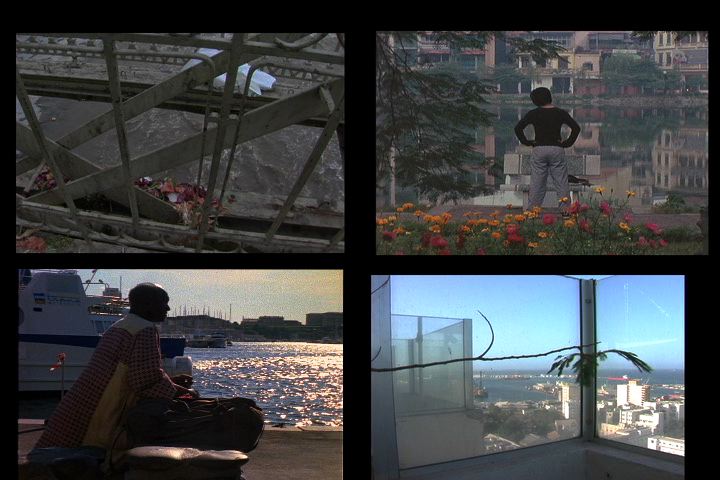
All fair and engaged questions from the group, I was happy to answer as best I could—though with a twinge of performance anxiety in the social spotlight.
As Emily let others ask their questions, I noticed her squirming in her chair, barely contained irritation bubbling to the surface. Finally she could hold back no longer. “I just don’t get it, Mark. Who’s asking you to make this film? Is anyone paying for it?”
I was momentarily stunned by the snarkiness of her question and just let the moment sink in. Emily’s question points to a gulf in ideologies that I’ve been thinking about a lot lately. Do you need societal backing to do what you want to do, or can you shrink the scale and create on your own terms? Do you need a financial directive, or can you shoot something on a shoestring and find it pleasing and communicative? Do you jump in and create or wait for support and infrastructure? In a way, I think it’s as much about how we see the world as it is about money. Are you answering a command with your artwork, or are you howling at the moon almost despite yourself? For better or worse, as unimpressive as it is at dinner parties, I’m firmly in the latter category.
Later I tried to engage an experimental musician to create music for the film. Again, I found myself at odds with prevailing assumptions. Despite the ostensible proximities of our disciplines, we were speaking different languages. We spoke about “process,” “an experimental feel,” being “bold with aesthetic choices.” If I had been afraid of “low” production values, I explained to him, I never would have gotten on the plane to Dakar. But he wouldn’t work on the project unless we followed a specific professionalized production model (scoring, rehearsal, professional studio recording) that I could ill afford because, you see, no one was paying for it.
At present, I’m sending around Hidden in Plain Sight to various festivals. As always, I’m irritated and deflated by film festival application questions that seem almost aggressive: world sales agent? publicist? In addition, I have to hem and haw over which box to check (experimental or documentary) to classify the film. These people are asking about a different kind of film, perhaps one Emily and the musician would like to see, with clear underwriters or a preordained place in the world.
With the kind of films I make, the idea of waiting for institutional support has always been anathema to me. I try to make films “out of necessity,” as Stan Brakhage wrote. He also decried the goal of professionalism, noting that the word amateur connotes the love of something rather than a hope of financial rewards. I never expect to make money on my films and never wait to be asked to make them. You wouldn’t ask a poet or painter about his financial backing, and probably not a novelist. It’s hard to communicate this ethos of self-sufficiency, but I believe in it.
| More: Writing
| More: Films
| More: Films
| More: Films
| More: Installations
| More: Films
Mark Street: Festival of Flights (2007)
August 27, 2007
Festivals of Flights
By Mark Street
Published in Release Print Magazine, December 2007
Over the past few months, I’ve had 2 vastly different but immensely satisfying film festival experiences. No awards, no gleaming headlines, not even packed houses, really, just a vague but edifying feeling that it makes sense to travel and show work and throw myself into the vortex.
I haven’t always felt this way. Some of the most alienated vignettes in my life (and there have been many) have happened at film festivals. I’ve felt an odd mix of galloping expectations, social awkwardness and misanthropy as I approach these gatherings. At other times I’ve felt like a Junior High student carrying my lunch tray past various cliques, wondering who my tribe is.
One recent festival visit confirmed my reclusive and anti-social propensities, another surprised me with its heartening, seemingly effortless stab at creating community. Both have given me a chance to think about why I both look forward to and fear these gatherings in equal measure. What makes for a good, or at least tolerable experience? What am I looking for, realistically, when I choose to enter a film in one of the many festivals that stretch out like beacons of possibility as I thumb through the back pages of the FAF magazine?
In 1990 my film Winterwheat got into a festival in Utah called the US Film Festival. I was quite happy with the news, but didn’t know quite how to place it. “Are you going?” asked my roommates on Page Street. It hadn’t even occurred to me. It seemed like a case of misplaced values—to travel for an 8-minute film screening. So I drank in the Mission District the night of the screening, facing east, vaguely, wondering about what I was missing.
The US Film Festival changed its name the next year to the Sundance Film Festival, and I kept my name but decided not to sit home and stew any more. The next time something similar came up I’d displace myself, face my expectations and fears and make a trip out of it.
In 2001 I did travel to Park City from Baltimore with an even shorter film, Sliding off the Edge of the World. A family member in the know told me that the FRONTIER SECTION was the cutting edge part of the program and that I was in good stead. Still, I had agrophobic visions of being on the outskirts, and on the plane I felt foolish and silly for coming so far for such a short film.

Before I left Baltimore I‘d called up my doctor to see about visiting him to get some antibiotics for a cough I had. “Everybody’s got a cough, Dr. Silverman is too busy.” said his secretary. “But I’m coughing up blood” I said. “Everybody’s coughing up blood.”
So it was off to Park City with a hacking cough and a seven-minute silent 35 mm film. “You must be so nervous, there’s so much at stake” said the 20- something casting agent at the cocktail party. “Not really” I thought to myself. “I’m not nervous, and there’s not that much at stake.” 7 minute silent 35mm films out on the frontier don’t exactly inspire market forces, as we all know. Later that night I visited a 24-hour clinic and got some antibiotics from a kindly nurse. Not exactly the Dionysian recreational drug experience I’d dreamed of, but I felt better.
Once I got a call from a festival in the Southwest about visiting with my first feature, At Home and Asea. “I’m glad to come, but I don’t want to come all the way out there if there are only six people in the audience.” I received some vague assurances. Sure enough, when the lights went dim on my Sunday afternoon screening there were exactly six people in the audience. But it didn’t stay that way: a couple got up and walked out after 10 minutes.
I was restless so I popped into the theatre next door to size up the competition, as it were. A huge crowd was watching a compendium of the “best” car commercials of the year.
To prove I’d really cured myself of my avoidance of travel, I once made it all the way to the European Media Arts Festival to show my short Sweep. A trans Atlantic flight to Amsterdam, then a 2-hour train ride into Germany left me worn and battered, but focused on the unassailable reason for the trip. Just before entering the film festival office it all seemed to slip away. Why had I come all this distance for something so small and insignificant? What if nobody liked the film? What if no one showed up and I feel ridiculous for having come all this way? I wanted to stay an anonymous traveler for a few more moments. I knew that when I entered those doors I’d be a festival attendee, with all its pursuant expectations and vagaries. I walked around the block to preserve the purity of the moment. When one hurtles oneself across the world for any inane reason (even as a tourist) there’s a humility and simplicity to it. To attend a festival is something else: it’s being open to being let down, to have one’s ironclad purpose and resolve be buffeted around in unpredictable circumstances.
But enough grouchy negativity, what about these recent festivals that worked out so well for me? The 2007 Tribeca Film Festival premiered my latest diary film (A Year) in a group show and I attended several other screenings and parties. I enjoyed standing on the outskirts, sipping vodka and nibbling on nuts as people swirled around me. “It’s so ANONYMOUS here” a fellow filmmaker complained. Maybe as I get older and more disassociated I have come to see the value of more distant social relations. Besides, in some sense shouldn’t a festival party mirror the essential state of film spectatorship: that we are at once alone and in company, but locked in our own private voyeuristic fantasy?
On the more intimate end of the scale in July I took a detour from a family vacation to descend on Marseille for a screening at the Festival des Films Contre La Nature (Festival of Films Against Nature.) I can’t imagine a more engaging mix of people, good hearted and kind, welcoming and hospitable. The films looked great up on a big screen in a small auditorium in the hills of Marseille. There was a mistral that weekend, and you could hear the ferocious wind outside the theatre like a ghostly soundtrack. It was an honor to see subversive and charged work bursting off the screen in such an exalted environment. It was a small group of people, but discussions were vibrant, wine flowed freely and I loved every minute of it. Every night after the last screening large tables were set up and our hosts served dinner, Last Supper style, to anyone who wanted to stay. I was moved by this committed and indefatiguable collection of people. Maybe my misanthropy is weakening.
So what is it I want from a festival? Splashy and soulless spreads? Heartfelt human interaction? Given the utter impossibility of any kind of tangible benefits I’m left to grasp onto small and unquantifiable rewards: a nice conversation, a feeling of belonging, a fleeting image on a screen glimpsed in an afternoon screening on the way to a wine bar. I like brushing up against filmmakers except when I don’t, and I often want to talk to people until I engage them, and then I just want to run away. I keep wondering if a plumbers convention is just as fraught with contradictions, complications and anxieties. How could it not be?
A few weeks ago I was walking home in Brooklyn and a woman yelled my name from across the street. It was Kristen Nutile, whose heart wrenching and wonderful film about her father Loss had played with mine at Tribeca. We waved and smiled at each other from across the street, and I thought again about her film, which resonated so deeply with me. Later that week I got a package from Marseille: my mini dv tape returned and also the prescription sunglasses I’d left on the table at the Last Supper. What a sweet and thoughtful gesture to send the glasses across the Atlantic to a scattered filmmaker! I’ve always resisted the notion of joining, but the community of festival participants seems like where I most belong.
| More: Writing
Mark Street: Film is Dead, Long Live Film (2007)
Film is Dead, Long Live Film
By Mark Street
Originally published in Release Print April 2007
In 1994 the San Francisco Police Department evacuated a whole block in the Mission District and blew up a home-made battery pack I’d made for my 16mm Bolex camera.
I had left the battery pack in the storage area of my girlfriend’s house along with broken suitcases, camping equipment and other boheme detritus that everyone seemed to leave on Cumberland St. All of our apartments were small, and my girlfriend and her sister had storage area to spare. The battery pack consisted of 4 lantern batteries in their original cardboard box, fastened with duct tape, with a single green wire protruding from the box to be attached to motor and then to the camera. My girlfriend’s sister saw the wire and box peeking out from the storage area as she parked her car in the garage and called the police.

After hearing about what had happened, I called one Sergeant Donahue to explain the situation.
“It was a battery pack for a film camera. I just wanted you to know it wasn’t a bomb.”
This was yesterday’s news to Sergeant Donahue.
“As far as I’m concerned this case is closed” he said and hung up. Bomb or no bomb, battery pack or no battery pack, that particular item was history.
I don’t miss that battery pack. It was cumbersome and I only used it on a few occasions, to shoot clouds in slow motion moving across the Bernal Heights skyline for my diary film Lifting Towards Chaos. But I hated to hear the policeman slam down that phone with such finality. It felt like an end, for me. The object itself held little significance, but the ethos of figuring out how to jerry rig something to fit onto a camera, those days seemed irretrievable all of a sudden.
It’s a much better story than it was useful object, and like some people it made more of a splash in death than it did in life. Maybe so it will be with film, better as a wisp of an ideal, a memory of a fleeting imperfect shadowplay across a white screen in the dark than the experience ever was. Film going was always just short of a dream— a sensual engagement rather than an object, an ephemeral event hard to contain and define.
I feel like I’ve been waiting for film to die my whole adult life. At Bard College in the mid 80’s the slick film majors had anecdotes and evidence about the end of celluloid. “It’ll all be video by next year” intoned Jed from Long Island, who I remember drove his red Porsche into a tree one drunken night. I shrugged at Jed’s dire predictions and went on scratching on black leader.
In the early 90’s I would tote my 16mm prints all over the country, only to have some curators take a quick took at the cans and say “Can’t we just show your stuff on VHS?” I shrugged it off.
In the late 90’s I got more calls then I needed from people GIVING AWAY flatbed editors and film prints, would I take them, please? As Baltimore’s City Salvage , (a repository for all the overflow of taxpayer purchased objects) closed its doors, I dutifully made a trip out there and loaded up my car with unwanted 16mm prints: Life of a Grasshopper, A Chance to Live: Nuclear Disaster and Blow, Wind, Blow, among others.
“I don’t know how many more 16mm films I have in me” I heard filmmaker after filmmaker say to me. This from the people who’d moved over to video. I can’t hold any kind of media choice against any working artist, so I shrugged some more.
I shrugged when the film departments where I have taught (in Florida, Baltimore and NYC) stopped paying to rent 16mm films.
I’ve never been a purist. Purism, like perfectionism, strikes me as some kind of ultimate hubris, as if one is taking one’s art too seriously, and the gods are waiting around the corner with a big stick. And yet I’m awkward with the transition, the inevitability of it all, the surging sense of loss.
The other day some students from the film preservation/archiving program at NYU came over to my house to help me store some of my film materials safely. They labeled everything with bright blue tape, inspected my prints and outtakes, and arranged everything neatly. I kept trying to get these folks to loosen up as they worked, feeling like they’d made it out to Brooklyn to do me a favor, of sorts, albeit one they were getting college credit for. But they had a sort of grim determination, like coroners or embalmers, as they adjusted a humidifier, inquired about the nature of the splices on my workprint, and stacked my plastic cores in rows.
I used to encourage my students to buy old cameras and projectors, dumpster dive at libraries giving away their collections, process their own film, engage the medium in some sort of punk, DIY aesthetic. But film is no longer the detritus of the culture, and using it is no longer a considered reaction against planned obsolescence. Film is the old grandfather in the corner who is demented and senile and repeats himself over and over again. It’s not underground, hip, indie or pure. It’s expensive and all but dead.
Ah, but we’ve lost some things. I remember watching my 8 minute film Echo Anthem (comprised of 16mm footage of the 1989 SF earthquake) 40 times in one weekend when I first got it back from the lab. The images flickered on my wall, and my cigarette smoke mingled with the projected light. It isn’t the same when you get a tape back from the lab. I remember seeing Stan Brakhage’s Mothlight for the first time, feeling like my world was shaken. It’s not the same on DVD. Just the other day I projected a print of Ernie Gehr’s Table. The colors were so vibrant, the screen so deep I felt like I was going to sink into it. With work like this, it’s not a question of degree—you simply can’t “get it” on tape or disk. For all practical purposes, those films don’t exist anymore.
Festivals don’t show 16mm much any more. For a stretch I made 35mm prints, but the expense made me wonder if I wasn’t being vain and hubristic in a new way. I send out tapes and disks, and festivals are overwhelmed with a glut of work made digitally which they slog through as best they can. It’s wonderful that more people can make more work except when it’s not: when quantity doesn’t equal quality and one yearns for the days when an idea had to be nurtured and worked, considered, and yes, paid for in order to be articulated. Maybe I’m more classist than I ever knew, and I miss the days when moving image making was not quite as populist.
The other night I drove to Williamsburg Brooklyn to check out the brand new moving image venue I’d heard about. Hipsters flocked on street corners, charting their pub crawls which start at 11 pm. Comic book and record (I mean CD) stores dot the landscape.
Monkeytown is a 50 foot square room with a 20 foot high screen on each wall. The video projection equipment sits in the middle of the room, and you sit facing one of the four walls, with all screens in view except the one behind you. They project feature films on video (2 at a time), documentaries and artists’ works. The night I went I saw abstract digital work shimmering on the screen as waitresses clad in work suits brought spicy meatballs and sesame oil baked codfish. After a few vodkas and glasses of white wine I settled back to watch the show, content to be slumping back and seeing images unfold, at once alone and in company, not quite in the dark, but almost.
I’ve always resisted the elegiac with regards to film, this most 20th century of mediums. Things change, and who cares about the actual stuff of film? The ideas that animated film as film are still alive and well and inspiring a generation of moving image makers who are hunched over their video editing equipment at home. But I wished I’d heard the clickety clack of a 16mm projector that night at Monkeytown, or seen a splice jump out of the gate. I miss total darkness, and scratching on the emulsion of found footage films. And I’m not shrugging off the demise of film anymore.
| More: Writing
| More: Films
Rockaway
August 27, 2005
(2005) video, color, sound, 75 mins.
Select Screenings:
- Tribeca Film Festival, 2005
- Rooftop Films, 2005
- Long Island Film Festival, 2005

| More: Films
Films 1984-2004
August 27, 2004
Alone, Apart: the dream reveals the waking day
(2004) 16mm, sound, color, 7 mins.
Selected Screenings:
- DUMBO Film and Video Festival, 2004
- Films Contre La Nature, Marseille, France, 2005
- Lower West Side Film Festival, NYC, 2005
Fulton Fish Market
(2003) 35mm, sound, color, 12 mins.
“…blends scenes of the legendary waterfront market filmed in the early hours of the morning with hand-painted, emulsion-scratched abstractions turning the place into something beautiful and mysterious.” – Stephen Holden, The New York Times
Selected Screenings:
- Tribeca Film Festival, 2004
- Maryland Film Festival, 2004
- Wisconsin Film Festival, 2004
- Museum of Modern Art, 2004
- NY Underground Film Festival, 2004
- Hallwalls, 2004
At Home and Asea
(2002) Video, color, sound, 70 mins.
“In At Home and Asea, Five Baltimore residents grapple –no self pity allowed–with their feelings of being stuck in lives that are less than meaningful. Street’s amalgam of documentary and fiction is poignant and, thanks to Guy Yarden’s score, anxiety-provoking. It’s also a subtly crafted portrait of an economically blighted city, pulled between North and South and central to neither.” – Amy Taubin, Village Voice
Experimental filmmaker Mark Street, who lives in Brooklyn and teaches at the University of Maryland, Baltimore County, returns to Filmforum with the L.A. premiere of At Home and Asea (2002), a collage of portraits charting the disillusionment shared by a group of Baltimore denizens. Street, whose previous work includes striking abstract pieces, as well as films in which he’s scratched and bleached the emulsion, here works with digital video; this allows him to capture intimate and casual moments with his subjects, who include three single mothers, a 23-year-old beer-drinking slacker and a man trying to understand his deceased father’s lpge by revisiting what the elderly man left behind. While it’s never entirely clear what’s scripted and what’s real, the video nevertheless gradually acquires a weighty torpor as the characters fight the inertia wrought by the exhausting, uphill struggle to create lives that live up to expectations. Street has always been adept at aligning invisible emotions with their physical counterparts, and here he perfectly captures his subjects’ anomie with images of Baltimore’s anonymous buildings and blighted neighborhoods. Their growing despair is perhaps best embodied, though, in shots showing boats bobbing slowly up and down on the gray water against the evanescent, lead-colored fog.” – Holly Willis, LA Weekly
Selected Screenings:
- Museum of Modern Art, 2003
- Blinding Light Cinema, 2003
- Squeaky Wheel, 2003
- Kansas City Filmmaker’s Jubilee, 2003
- Berks Filmmakers, 2003
- Dallas Video Festival, 2003
- Mill Valley Film Festival, 2002
- Wisconsin Film Festival, 2002
- Johns Hopkins Film Festival, 2002
- Media Co-op Digital Film Festival, 2002
- Pioneer Theatre, 2002
- Anthology Film Archives, 2002
- Film Forum, 2002
- Red Eye Theater, 2002
- Creative Alliance Moviemakers, 2002
Guiding Fictions
(2002) 35mm, color, sound, 5 mins.
Selected Screenings:
- Viennale International Film Festival, 2003
- Ann Arbor Film Festival, 2003
- Black Maria Film Festival, 2003
- Wisconsin Film Festival, 2003
- Athens Film Festival, 2003
- European Media Arts Festival, 2003
- New York Film Festival, 2002
- DUMBO Film Festival, 2002
Brooklyn Promenade
(2001) 16mm/dvcam., 3 mins.
Selected Screenings:
- Reel 13, NY, 2002
- The Kitchen, 2002
- Cornelia St. Cafe, 2002
- LA Freewaves, 2002
- Creative Alliance Moviemakers, 2002
- Black Bear Film Festival, 2002
The Domestic Universe
(2001) color, sound, video., 17 mins
“The Domestic Universe is a poetic meditation on intimacy and the swoon of new fatherhood… often assumes the visual perspective of a crawling, exploring child. But mostly the movie captures the shifting tectonics of gender roles.“ – Ann Hornaday, Baltimore Sun
Happy?
(2000) BetaSP, color, sound., 20 mins
Sliding off the Edge of the World
(2000) 35mm (16mm print available), silent, color., 7 mins.
Sweep
(1998) 16mm, color, sound., 7 mins
Why Live Here?
(1996) 16mm, sound, color., 60 mins
Triptych
(1995) 16mm, color, sound, triple projection., 13 mins
Excursions
(1994) 16mm, color, sound., 26 mins
Selected Screenings:
Blue Movie
(1994) 16mm, color, sound., 5 mins
Selected Screenings:
- Ann Arbor Film Festival
- Black Maria Film Festival
- Pandaemonium Festival, London
- Semana de Cine Experimental
- Humboldt Film Festival
- New York Underground Film Festival
Missing Something Somewhere
(1992) 16mm, color, sound, 17 mins
Selected Screenings:
Echo Anthem
(1991) 16mm, color, sound., 8 mins
Selected Screenings:
Lilting Toward Chaos
(1990) 16mm, color, sound., 21 mins
Winterwheat
(1989) 16mm, color, sound, 8 mins
Selected Screenings:
- Ann Arbor Film Festival
- San Francisco Film Festival
- Sundance Film Festival
- Athens Film Festival
- Denver Film Festival
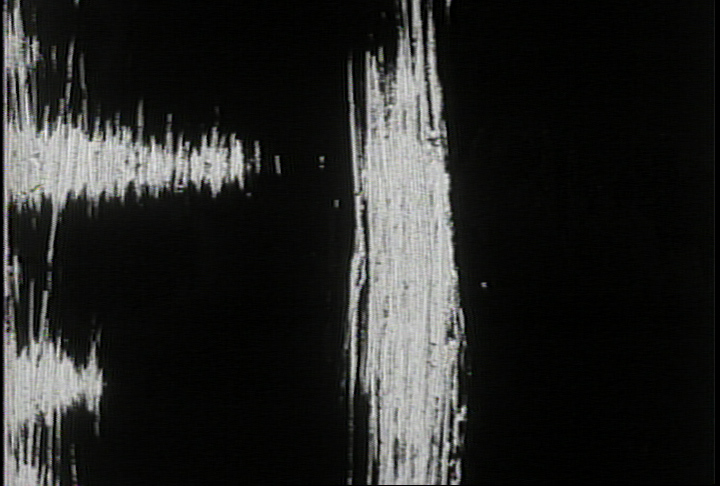
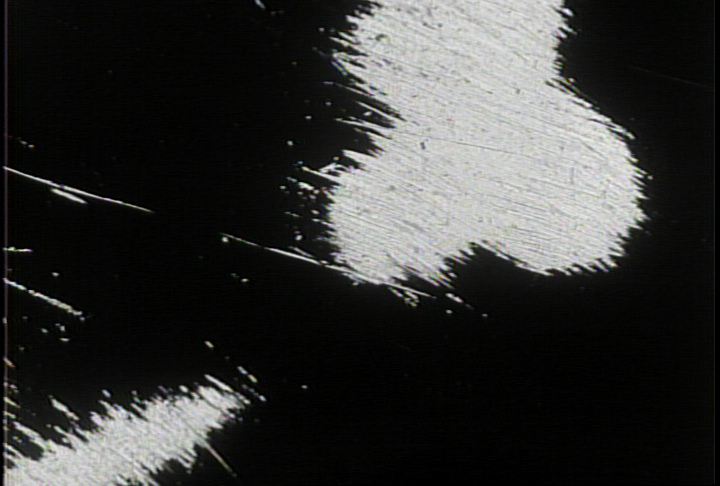
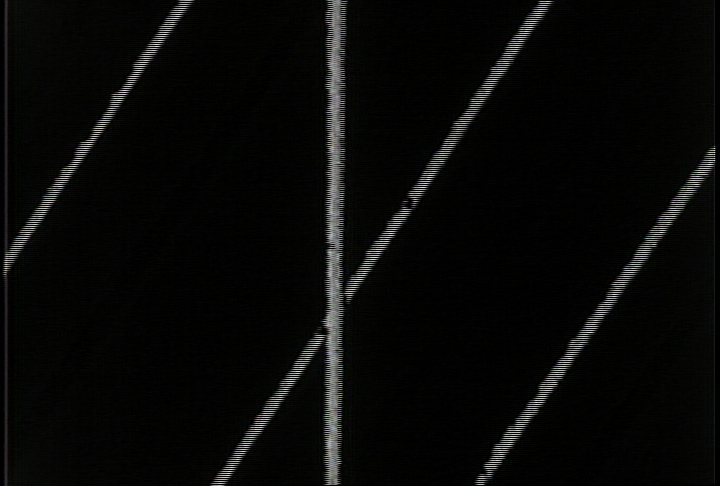
Scratch
(1984) 16mm, black and white, sound, 3 min
First film. Tearing away at the emulsion, searching for a soundtrack amidst everyday objects.


